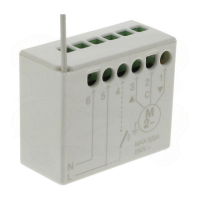6
4.2.3) Example of combined Mode I and Mode II memorisation
The combination of memorisation procedures combining Mode I and Mode II enables the creation of group commands as shown in the
example of figure 4.
• Transmitter T1 (Ergo1) memorised using Mode I on A1 and A2
commands the movements UP, STOP and DOWN simultaneously
of both A1 and A2.
• Transmitter T2 (Plano1) memorised using Mode I only on A3 com-
mands the movements UP, STOP and DOWN exclusively of A3.
• Transmitter T3 (Planotime) memorised using Mode I only on A4 com-
mands the movements UP, STOP and DOWN exclusively of A4.
• Transmitter T4 (WM001C) memorised using Mode II (Step-by-
Step) commands A4 only.
• Transmitter T5 (WM003G) memorised using Mode I to command
with group 1 on A1 and A2, with group 2 on A3, and with group
3 on A4, commands the movements UP, STOP and DOWN of A1
and A2, A3 or A4.
• Transmitter T6 (Flo4R) memorised using Mode II on A4 (keys 1 and
3) on A5 (key 2) and on A6 (key 4), commands the UP and DOWN
movements of A4, or opening of the garage door A5 or opening of
the automatic gate A6.
• With a transmitter memorised using Mode II some functions cannot be programmed if settings require activation of different
keys, for example key n and key s.
• With a transmitter memorised using Mode II “multiple group” commands cannot be used.
To memorise a transmitter using Mode II, when the programming pushbutton is accessible, proceed as follows.
4
1. Press the programming pushbutton the number of times corresponding to the required
command (1 = Step-by-Step, 2 = Up-Stop, 3 = Down-Stop, 4 = Stop, 5 = Hold-to-run
Down, 6 = Hold-to-run Up).
2. Check that the led emits the number of long flashes corresponding to the required
command.
3. Within 10 seconds press the required key of the transmitter to be memorised for at
least 3 seconds.
4. If the memorisation procedure is successful, the led emits 3 long flashes.
Note. If there are other transmitters to be memorised, for the same command selected in point 1, repeat point 3 within a further 10 seconds;
otherwise if the command is different, repeat point 1; the memorisation phase terminates if no new transmitters are received within a 10
second interval.
Table “A8” Memorisation using Mode II with the programming pushbutton Example
1-6
1-6
3s
1. Press and hold the key to be memorised of the new transmitter for at least 3
seconds, then release.
2. Press and hold the previously memorised key of the old transmitter for at least
3 seconds, then release.
3. Press and hold the key to be memorised of the new transmitter for at least 3
seconds, then release.
4. Press and hold the previously memorised key of the old transmitter for at least
3 seconds, then release.
Memorisation of a new transmitter is simply, maintaining the same characteristics of the previous transmitter. The new transmitter memorised
in this way will inherit the characteristics of the old transmitter; in other words if the previous one was memorised using Mode I, the new one
will also operate in Mode I, and if the previous one was memorised in Mode II, the same key on the new transmitter will be associated with
the same command as the previous version. For memorisation, proceed as follows.
Table “A9” Memorising other transmitters with a previously memorised transmitter Example
New
Old
3s
3s
Old 3s
New 3s
4.3) Work time
The TT2N control unit enables entry of a work time, i.e. the maximum time for which the electronic board controls the motor to reach the
up or down limit switch; the factory setting or reset value after clearing the memory is approx. 150 seconds. If required, the work time can
be modified from a minimum of 4 seconds to a maximum of 240. The programming procedure is performed in “self-learning” mode, i.e. by
measuring the time required for the entire manoeuvre. With a transmitter or the external pushbutton, the motor must be activated through to
the least difficult manoeuvre, until the next manoeuvre is the most difficult, normally rewinding. It is recommended to program the work time
with a few seconds more than the time strictly needed for the manoeuvre (point 5 in table A10). The work time can be programmed either
with a transmitter memorised in Mode I, or with the programming pushbutton, but not with a transmitter memorised in Mode II.
EN

